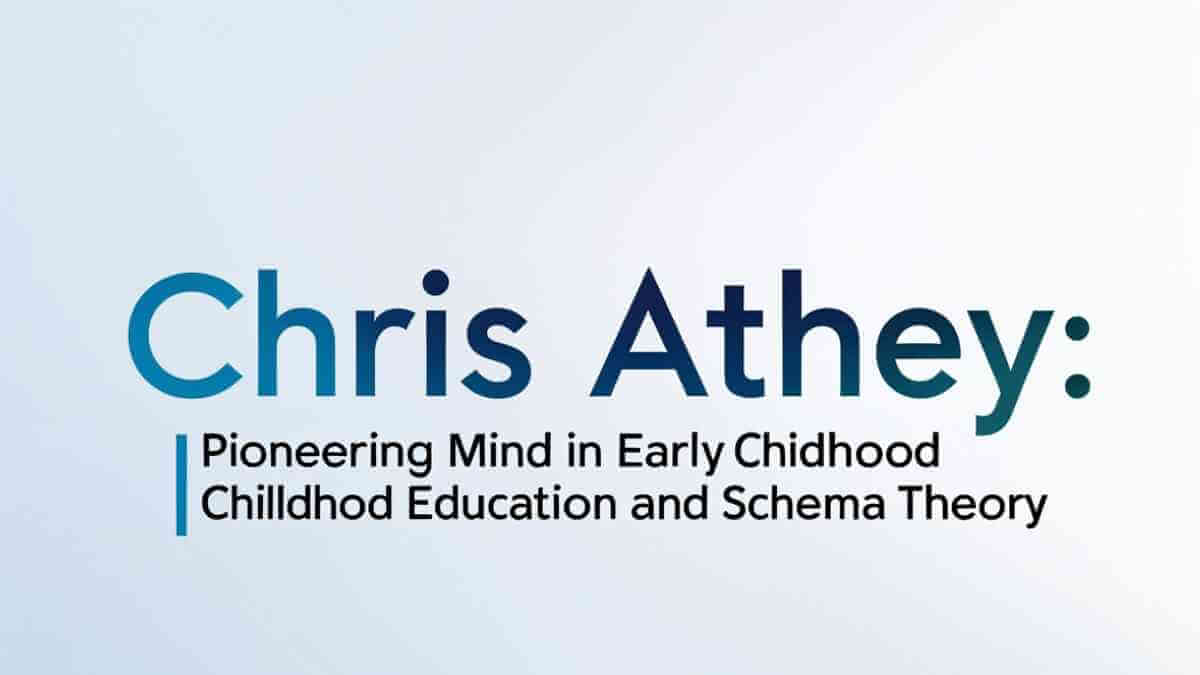Chris Athey: Pioneering Mind in Early Childhood Education and Schema Theory

Chris Athey stands as one of the most influential figures in the field of early childhood education. Her work transformed how teachers, parents, and researchers understand the way young children learn, think, and develop. Born in 1924 in South Shields, England, and passing away in 2011, Athey devoted her life to studying children’s cognitive growth. She is best known for introducing and popularising the concept of “schemas” in early-years practice, making complex theories of child development practical for everyday teaching. Through decades of dedication, she reshaped the way educators observe play, interpret patterns of learning, and design experiences that nurture children’s emerging ideas.
Early Life and Academic Background
Chris Athey grew up in the northeast of England, a region known for its strong sense of community and tradition of valuing education. Although details of her early schooling remain relatively private, her later career reflects a deep commitment to rigorous study and a belief in the power of education to transform lives. Athey trained as a teacher during a period when early childhood education was beginning to shift from simple custodial care towards a deeper understanding of child development. Her academic path eventually led her to the Froebel Educational Institute and later to the Roehampton Institute of Higher Education, where she would leave an indelible mark on the study of young children’s thinking.
The Froebel Early Education Project
One of Athey’s most significant contributions emerged from her leadership of the Froebel Early Education Project between 1973 and 1978. This project was more than just a research initiative; it was a groundbreaking exploration of how very young children develop concepts and represent their understanding of the world. Working with a team of educators and researchers, Athey carefully observed children in natural play settings. Instead of viewing their actions as random or purely playful, she noticed recurring patterns—repetitive movements and behaviours that seemed to have a deeper cognitive purpose. These observations formed the foundation of her interpretation of schema theory within early education.
The Froebel project highlighted how children express their thoughts not only through language but also through physical actions, drawings, and symbolic play. Athey and her colleagues documented how these expressions evolved over time, tracing the path from simple movement to complex, abstract thought. Their findings revealed that children’s play was not mere entertainment but a sophisticated form of inquiry and problem-solving.
Understanding Schema Theory
At the heart of Chris Athey’s legacy lies her development and application of schema theory. The term “schema” originates in psychology and refers to an internal structure or mental pattern that helps individuals organise and interpret information. Athey recognised that young children reveal their schemas through repeated behaviours and interests. For example, a child might constantly move objects from one place to another, explore lines and trajectories, or arrange toys in particular patterns. Far from being meaningless repetition, these actions demonstrate the child’s efforts to make sense of spatial relationships, movement, and structure.
Athey identified several key types of schemas, including transporting, enveloping, trajectory, rotation, and connecting. Each type represents a different area of cognitive exploration. A child who enjoys transporting objects from room to room is exploring ideas of movement and containment. One who endlessly draws circles or spins wheels is experimenting with rotation. Teachers who understand these schemas can plan activities and environments that support and extend children’s natural investigations, rather than interrupting or misunderstanding them.
Stages of Cognitive Development in Schemas
Chris Athey also outlined how schemas develop through distinct stages. Children begin at the motor level, where they physically enact a pattern. Over time, they move to a symbolic level, representing the schema in drawings or models. Next comes a functional or relational stage, where they see how different schemas interact or depend on each other. Finally, children reach a level of thought, where they can explain, predict, and reason about these patterns in language and abstract concepts. This progression shows how play leads naturally to higher-order thinking and intellectual growth.
Extending Thought in Young Children
The culmination of Athey’s research and insights appeared in her influential book Extending Thought in Young Children: A Parent–Teacher Partnership. First published in 1990 and later revised in 2007, this work remains a cornerstone for early childhood educators. In it, Athey emphasised the importance of collaboration between parents and teachers. She argued that adults should not merely instruct but should also observe, listen, and build on the thinking that children demonstrate through play. By recognising schemas, parents and teachers can work together to create rich experiences that stretch children’s minds and help them make connections across different areas of knowledge.
The book also highlighted the continuity of children’s thinking as they transition from early years settings into formal schooling. Athey showed that when teachers value and extend the ideas children bring from their play, learning becomes more meaningful and lasting. This focus on partnership and respect for children’s own ideas was revolutionary for its time and continues to influence early-years practice today.
Influence on Early Childhood Practice
Chris Athey’s ideas have had a lasting impact on how early childhood education is understood and delivered, particularly in the United Kingdom. Her emphasis on schemas has become a standard element of teacher training and early-years curriculum design. Practitioners now routinely observe children’s play to identify the schemas they are exploring and use this understanding to plan activities that nurture cognitive development. For example, a child fascinated by lining up blocks might be given opportunities to explore patterns in art or mathematics, while one who constantly fills and empties containers might be encouraged to experiment with volume and measurement.
Her work also shifted the culture of early-years education from one of control to one of collaboration and respect. Instead of viewing children’s repetitive behaviours as problematic or aimless, educators now see them as vital clues to the child’s developing mind. This change in perspective has fostered environments where children’s curiosity is valued and their play is recognised as a powerful engine of learning.
Legacy and Recognition
Chris Athey’s death in 2011 marked the end of an extraordinary career, but her influence endures. Her theories are now embedded in early childhood education training and practice across the UK and beyond. Many early-years frameworks and curricula explicitly reference schemas and encourage teachers to use Athey’s insights when planning for learning. Researchers continue to build on her work, exploring how schemas interact with language development, creativity, and even digital play in the modern classroom.
Her legacy is not only academic but deeply practical. Teachers who have embraced her ideas report more meaningful interactions with children and a deeper appreciation for the complexity of early learning. Parents who understand schemas often find new ways to engage with their children’s play, turning everyday activities into opportunities for discovery.
Conclusion
Chris Athey transformed the understanding of early childhood education by bringing schema theory into the heart of teaching and learning. Through her leadership of the Froebel Early Education Project and her landmark book Extending Thought in Young Children, she showed that young children are active thinkers who reveal their intellectual processes through play. By recognising and nurturing schemas, educators and parents can extend children’s thoughts, fostering creativity, problem-solving, and lifelong curiosity. Her work continues to inspire educators around the world, ensuring that the smallest actions of children—whether lining up toys, spinning wheels, or carrying objects—are valued as the beginnings of great ideas and deep understanding.



